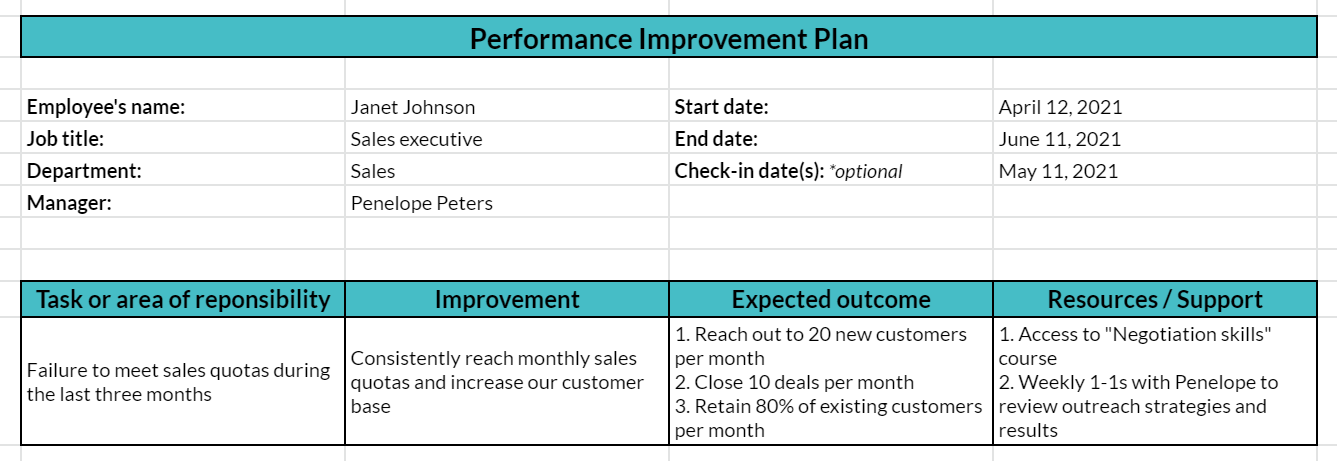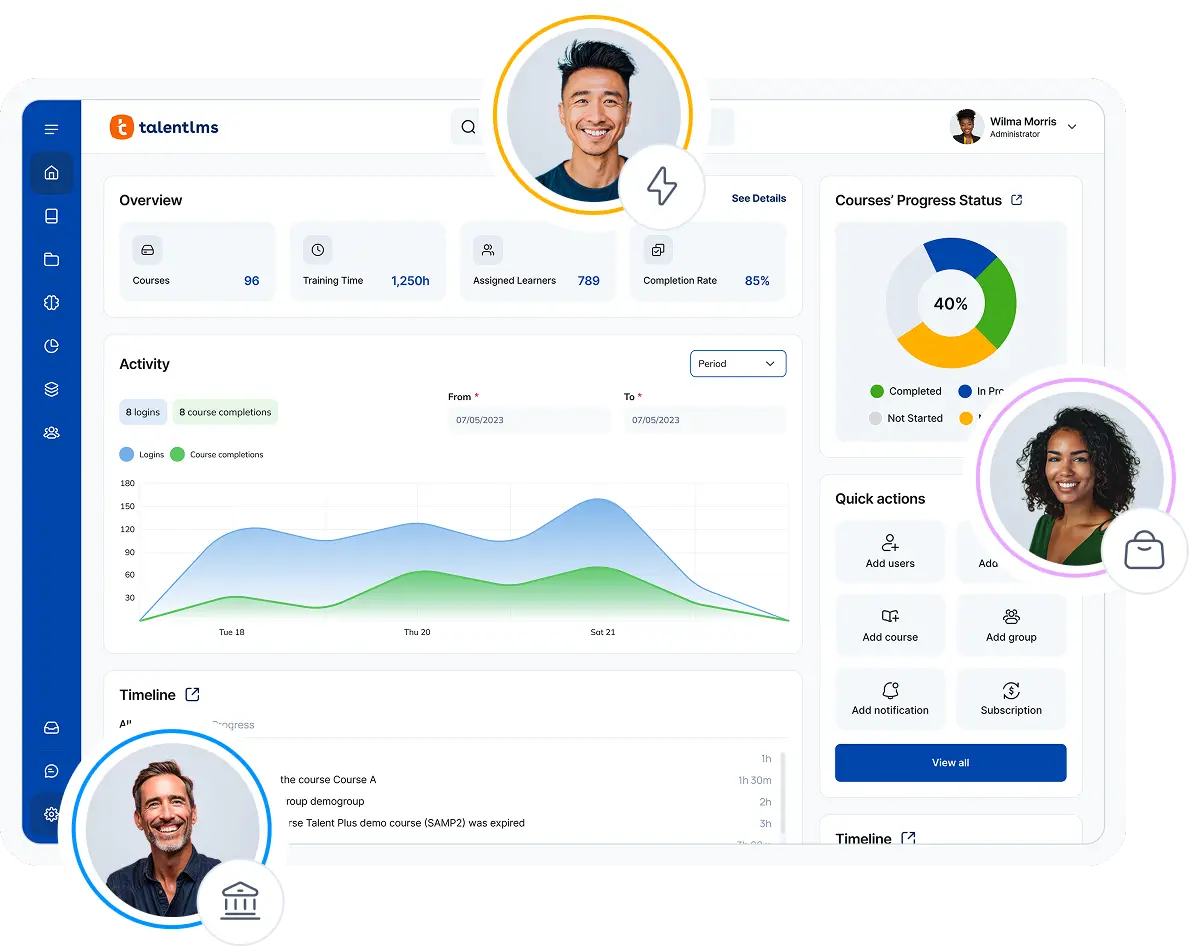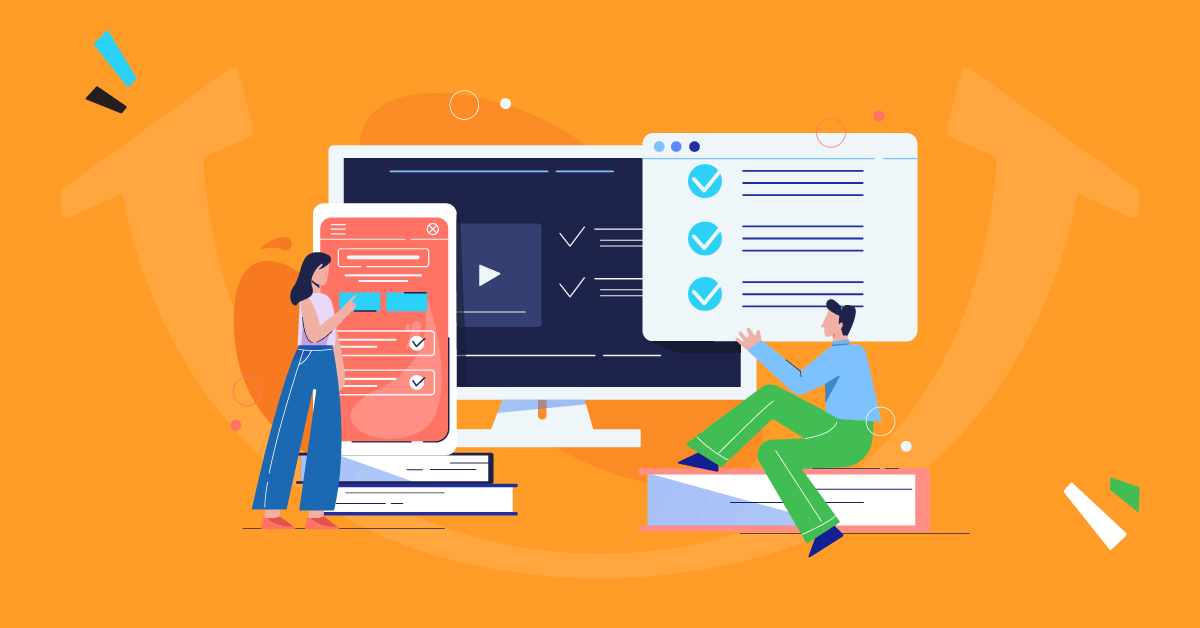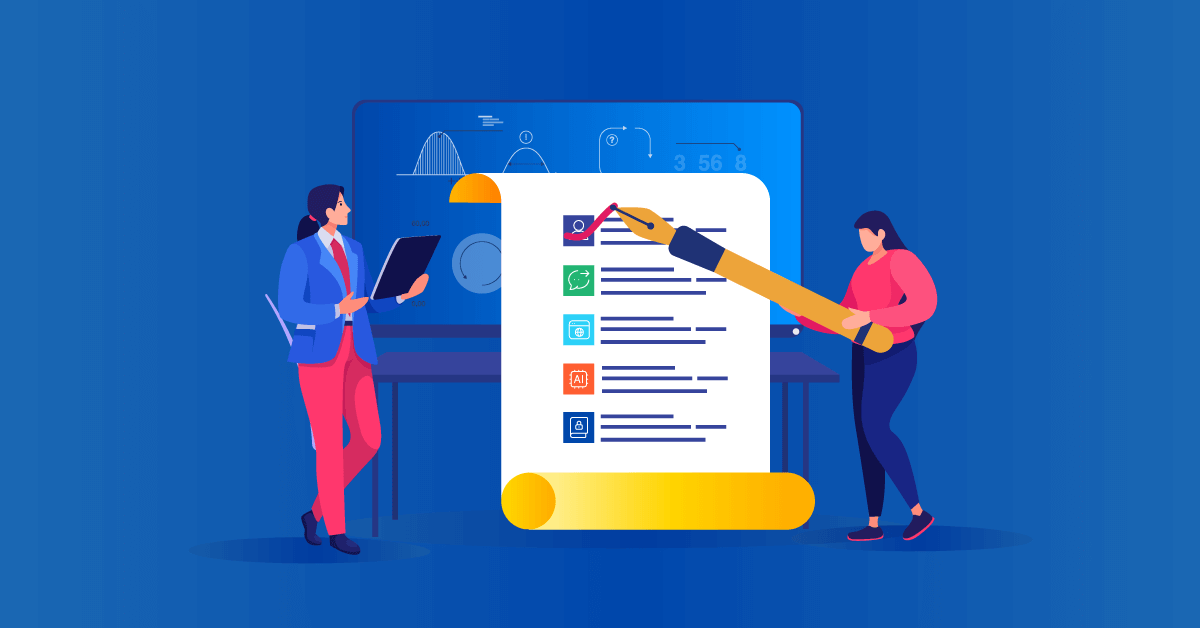- What is a performance improvement plan (PIP)?
- Why you should use a PIP
- When is a performance improvement plan the best option?
- What should a performance improvement plan include?
- 7 steps to create a performance improvement plan
- Tips to make a performance improvement plan more effective
- Performance improvement plan (PIP) template with example
- Building trust through performance improvement plans
Performance management is rarely smooth sailing.
Sometimes, despite our best efforts, an employee’s performance falls short of expectations or things like mergers or skills gaps derail your team’s performance.
No matter the reason, a well-crafted performance improvement plan (PIP) is a tried and true solution.
This guide will walk you through everything you need to know about performance improvement plans, from identifying when they’re necessary to implementing them effectively. Plus, we’ve included a free, downloadable performance improvement plan template to make the process even easier.
What is a performance improvement plan (PIP)?
A performance improvement plan (PIP plan) is a formal document that outlines specific employee performance deficiencies, sets clear expectations for improvement, and offers a structured framework for achieving those performance goals. It’s a key element of the performance management process.
It’s a collaborative effort between the employer and employee, designed to address performance gaps and support the employee in getting back on track.
A well-implemented PIP helps employees understand where they’re falling short, receive the necessary support, and ultimately succeed in their roles.
Why you should use a PIP
PIPs are valuable tools for several reasons.
For starters, they cut through ambiguity by clearly defining performance deficiencies and the expected standards, which keeps everyone on the same page and working towards the same goals.
Furthermore, a PIP isn’t just about identifying problems—it’s about supplying employees with the resources and support they need to improve. Support might include employee training, mentoring, or adjusted responsibilities.
Performance improvement plans also create a formal record of performance issues, the steps taken to address them, and the employee’s progress. This documentation is especially important for legal protection and for monitoring performance management.
In addition, by setting clear expectations and timelines, they can motivate employees to take ownership of their performance and work towards improvement. It also establishes a framework for accountability, ascertaining that the employee and the employer are committed to the PIP process.
Performance improvement plans also offer a chance to retain valuable employees who may be going through a rough patch. Instead of resorting to immediate termination, a PIP can help them overcome challenges and continue contributing to the company.

When is a performance improvement plan the best option?
That being said, when to pull the trigger on a PIP? It’s not something you want to use for every small performance problem, but it’s a life-saving tool when you have constant or big problems.
Here’s the lowdown:
The “this isn’t getting any better” situation
This is probably the most common reason for a performance improvement plan. You’ve got an underperforming employee who, despite all your constructive feedback, coaching, and attempts to help, just isn’t meeting expectations. A PIP helps you formalize things, giving them a clear path to progress with measurable goals.
The “what happened?!” moment
When a top performer suddenly starts to slip, it can be a real head-scratcher. Maybe something’s going on in their personal life, or perhaps their role has shifted, and they’re struggling to adapt. A PIP can help you get to the bottom of it and support them in getting back on track.
When behavior becomes a problem
Sometimes it’s not just about the work itself, but how someone’s behaving in the workplace. Constant lateness, not playing well with others, and unprofessional conduct can really disrupt the team. A PIP lets you address these issues head-on and set clear expectations for how things need to change.
After a formal warning
If you’ve already had to give someone a formal warning, a PIP can be a good next step. It shows that you’re serious about the situation and gives them a structured opportunity to turn things around.
A proactive approach
Some companies actually use employee performance improvement plans proactively as part of their performance management process. This can be especially helpful for new employees or those who are finding their feet in a new role.
The “quietly disengaged” employee
This is the person who’s not necessarily causing a ruckus or making big mistakes, but who’s become withdrawn, unmotivated, and their work quality is slipping. A PIP can be a way to open a dialogue, understand what’s behind their disengagement, and see if you can re-ignite their passion or help them find a better fit within the company.
The “skills gap” situation
Sometimes an employee’s performance suffers because their skills haven’t kept pace with the evolving demands of their role or the company’s direction. A PIP, in this case, can be used to help identify those skill gaps and create a development plan that includes training, mentoring, or even a shift in responsibilities to better align with their strengths.
The “post-merger/acquisition integration” challenge
When companies merge or one acquires another, there can be a lot of upheaval and uncertainty for employees. Roles might change, new systems are implemented, and cultures clash. A PIP can provide much-needed structure and support during this transition, helping employees adapt to the new environment and expectations.
What should a performance improvement plan include?
A well-structured PIP plan needs to cover all the bases, leaving no room for ambiguity or misinterpretation.
Here’s a breakdown of the essential elements:
- Clearly defined performance issues: Start by specifically outlining the areas where the employee is falling short. Be precise and provide concrete examples. Instead of saying “poor communication,” specify “frequent missed deadlines due to lack of updates to the team.”
- Specific, measurable, and achievable goals: Vague performance goals like “improve attitude” are unhelpful. Set specific, measurable, and achievable goals that provide a clear target for improvement. For example, “Reduce customer support response time by 15% within the next month.”
- A detailed action plan: Outline the steps the employee needs to take to achieve those goals. This might include attending training sessions, shadowing a senior colleague, or implementing new work strategies.
- Support and resources: Clearly state what support the company will provide, such as mentoring, coaching, additional training, or adjusted responsibilities.
- Timelines and review dates: Establish a clear timeline with specific review dates to monitor progress.
- Consequences of not meeting expectations: While the focus is on improvement, it’s essential to be transparent about the potential consequences if the employee fails to meet the goals outlined in the PIP. This might include further disciplinary action or, in some cases, termination of employment.
- Employee and manager signatures: Both the employee and their manager should sign the PIP to acknowledge their understanding and commitment to the process.
Get your free performance improvement plan template now and get started!
7 steps to create a performance improvement plan
Crafting an effective performance improvement plan requires careful consideration and a structured approach.
Let’s walk you through a step-by-step guide to help you navigate the process:
Step 1: Gather the facts
Before you even start writing, it’s best to have all your ducks in a row. The more objective evidence you have, the stronger your PIP will be.
This means digging into past performance reviews to spot any recurring patterns, reviewing any documentation of previous feedback (like emails or meeting notes), and gathering specific examples of where the employee fell short.
You might also want to get input from other colleagues who work closely with them, just to get a well-rounded perspective.
Step 2: Schedule a meeting with the employee
Once you’ve got a clear picture of the employee performance issues, it’s time for a face-to-face chat with the employee.
During the meeting you can clearly explain the concerns, supply specific examples, and actively listen to their perspective.
The goal is to work together to set those improvement goals and ensure the employee feels supported, not cornered.
Step 3: Draft the performance improvement plan
Now it’s time to translate those conversations and findings into a formal PIP document.
Remember to include all the essentials:
- A clear description of the performance issues
- Specific and measurable goals
- A detailed action plan
- The support they can expect
- Timelines and review dates
- And the potential consequences if expectations aren’t met
Keep the language straightforward, concise, and focused on solutions, not blame.
Step 4: Review and finalize the performance improvement plan
Before you present the PIP to the employee, it’s always a good idea to have another pair of eyes on it. Get someone from the HR team or a senior manager to review it, just to make sure it’s legally sound, aligns with company policies, and is fair to the employee.
Step 5: Meet with the employee to discuss the performance improvement plan
Schedule another meeting with the employee to officially present the PIP.
Take them through the document step-by-step, answer any questions they might have, and give them time to digest it all. Make sure they understand what’s expected of them and how they can actively participate in the process.
Once everyone’s on the same page, both the employee and manager should sign the document.
Step 6: Monitor progress and provide ongoing support
Like many things in HR and L&D, a performance improvement plan isn’t a one-and-done deal. You need to stay involved and provide ongoing support.
So ensure you schedule regular check-in meetings to review progress, offer guidance, and adjust the plan if needed. Keep detailed records of these interactions and integrate it into your overall performance evaluation system.
Your active involvement can make a huge difference in the outcome.
Step 7: Evaluate and conclude the PIP
Once the PIP timeline is complete, it’s time to assess how things went.
Did the employee meet or exceed expectations? Great! Formally acknowledge their achievements and see if any adjustments to their role are needed.
If the employee has not met the goals, follow the consequences outlined in the performance improvement plan. This may include further disciplinary action, exploring alternative roles within the company if suitable, or, in some cases, termination of employment.
Tips to make a performance improvement plan more effective
Creating a PIP is one thing, but making it truly impactful requires a bit more finesse.
- It’s best to ditch the “gotcha” mentality. If the employee feels like the PIP is a weapon used against them, it’s doomed to fail. Instead, approach their poor performance with genuine empathy plus a focus on support and you’ll get better results.
- Remember to focus on the “why”. Connect their individual performance to the team’s goals, the company’s success, and even their own career development. When they see the bigger picture, they’re more likely to buy into the process.
- Don’t skimp on the support. A PIP without adequate support is like a car without fuel—it’s not going anywhere quickly or even at all. Actively connect the employee with mentors, arrange for relevant training, and provide regular coaching.
- Keep in mind that improvement isn’t always a linear journey. There will be bumps along the road. Acknowledge and celebrate every step forward, no matter how small. This positive reinforcement can boost morale and keep employees motivated, even when things get tough.
- Don’t be afraid to adjust performance goals, timelines, or support. In a similar vein, sometimes, despite everyone’s best efforts, the initial plan might not be hitting the mark. Regularly review the PIP and be open to making changes based on the employee’s progress and feedback.
Performance improvement plan (PIP) template with example
We’ve talked a lot about what goes into a PIP, but sometimes seeing it in action is worth a thousand words. Let’s take a look at some performance improvement plan examples and how how our template can be used to address these scenarios.
Scenario 1: Let’s pretend we have a sales executive named Janet Johnson who has consistently missed her sales quotas for the past three months. Despite receiving feedback and some additional training, her performance hasn’t improved.
Using the template:
1. Employee Information: Fill in the basic details: Janet Johnson’s name, job title (Sales Executive), department (Sales), manager’s name (Penelope Peters), and the start and end dates for the PIP (January 12, 2025, to March 11, 2025). You might also include a planned check-in date (February 11, 2025).
2. Task or Area of Responsibility: Clearly state the area where Janet is underperforming: “Failure to meet sales quotas during the last three months.”
3. Improvement: Describe the desired improvement: “Consistently reach monthly sales quotas and increase our customer base.”
4. Expected Outcome: Set specific, measurable goals:
- “Reach out to 20 new customers per month.”
- “Close 10 deals per month.”
- “Retain 80% of existing customers per month.”
5. Resources/Support: Outline the support Janet will receive:
- “Access to a “Negotiation skills” course.”
- “Weekly one-on-one meetings with Penelope to review outreach strategies and results.”
Scenario 2: Let’s pretend we have a sales executive named Alex Martinez who has consistently missed her sales quotas for the past three months. Despite receiving feedback and some additional training, her performance hasn’t improved.
Using the template:
1. Employee Information: Fill in the basic details: Alex Martinez’s name, job title (Software Developer), department (Engineering), manager’s name (Neena Watson), and the start and end dates for the PIP (March 10, 2025, to June 10, 2025). You might also include a planned check-in date (May 10, 2025).
2. Task or Area of Responsibility: Clearly state the area where Alex is underperforming: “Failure to meet project deadlines and submitting error-prone code in the last three months.”
3. Improvement: Describe the desired improvement: “Deliver high-quality code on time while adhering to company coding standards and best practices.”
4. Expected Outcome: Set specific, measurable goals:
- “Complete assigned tasks by their agreed-upon deadlines.”
- “Reduce code errors by 50% compared to previous submissions.”
- “Participate in two peer code reviews per sprint to improve collaboration and feedback.”
5. Resources/Support: Outline the support Janet will receive:
- “Access to an advanced course on debugging and clean coding practices.”
- “Pair programming sessions with a senior developer twice a week.”
- “Weekly check-ins with Taylor to assess progress, discuss challenges, and adjust strategies.”
You can use the examples in our template and adjust it to fit your own performance improvement plan needs.

Building trust through performance improvement plans
It’s easy to get caught up in the mechanics of performance improvement plans—the forms, the goals, the deadlines. But let’s take a step back and consider the bigger picture.
What if, instead of viewing a PIP as just a tool for correcting underperformance, we saw it as an opportunity to strengthen the bond between a manager and their employee?
Think about it. When a PIP is handled with genuine empathy and transparency, it can actually become a powerful trust-building exercise. It shows the employee that you’re not just interested in ticking boxes, but that you’re genuinely invested in their success. You’re saying, “I see your potential, and I’m here to help you unlock it.”
Of course, this requires a delicate balance. But when done right, this shift in perspective can transform the entire dynamic.
And that, in the long run, is a win for everyone.
Originally published on: 12 Apr 2021




